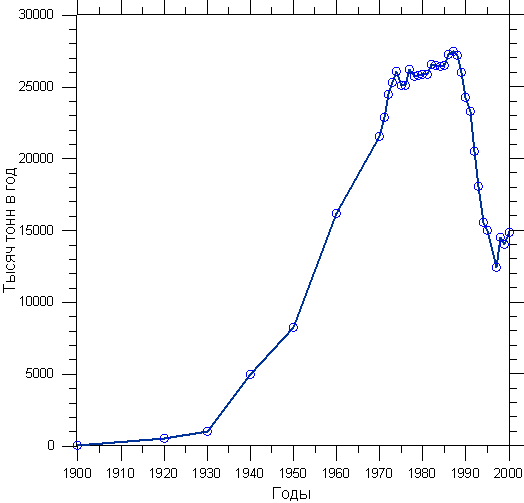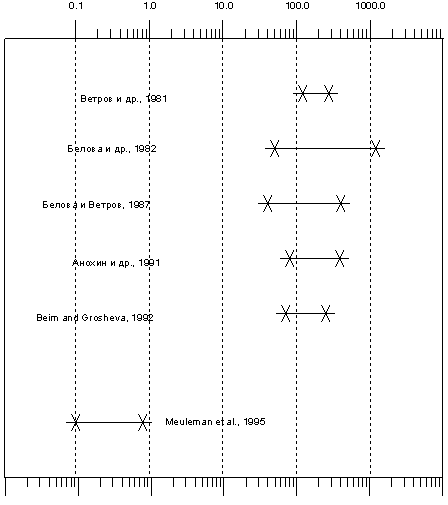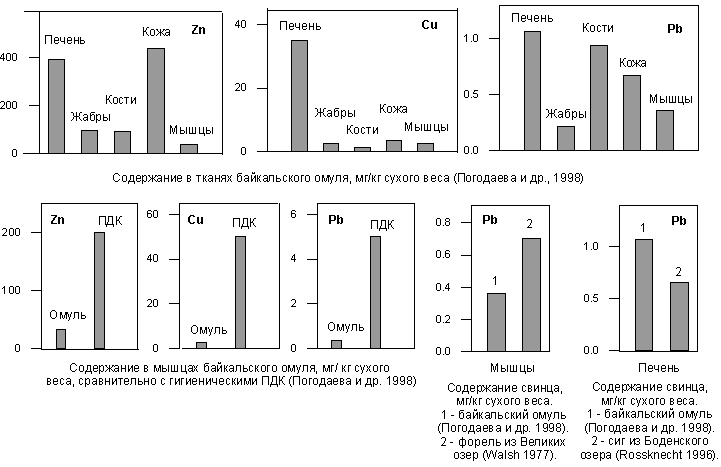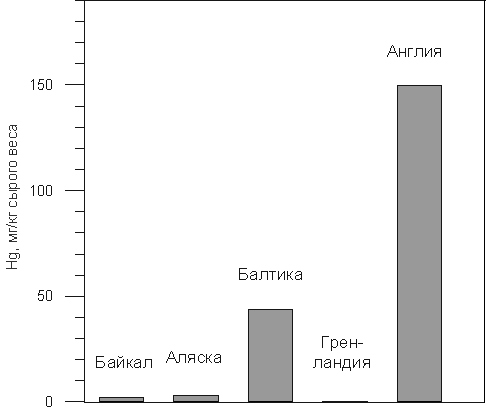Minor Elements, Including Heavy Metals and Radioactive Isotopes
Copper in Waters of Lake Baikal
Published papers, including official reports, present contradictory information on the concentration of heavy metals in waters of Lake Baikal. Let us consider this situation for copper. Russian regulations concerning protection of fish stipulate that the concentration of copper in water bodies should be below 0.001 mg/1 (= 1 µ g/l). Annual Report of the Governmental Commission on Lake Baikal (1997, p. 25) claims that the mean annual concentration of copper along the transect in the middle of Lake Baikal was 7 µg/l, and the maximum concentration was equal to 9 µ g/l, i.e. 7 and 9 times more than maximum permissible values.
Falkner et al. (1997) present different data (Fig.2.2.1). Their studies revealed that the concentrations of copper at all stations and depths were lower than 0.35 µg/1, 20 times smaller than those claimed by the Annual Report (1997). The reasons of this great discrepancy are not known. One of them is probably the method of preparation of samples prior to analysis, in particularly, removal of solid particles. The Russian fish-protecting regulations refer to copper in the dissolved form, because copper present in solid particles is practically non-toxic to fish. Remarkably, the Annual Report ...(1997) does not describe the method of removing of solid particles. The data presented in this report seem to be very doubtful. The three basins of Lake Baikal are inhabited by endemic fishes which are highly sensitive to contamination, like omul, golomyankas, bottom sculpins, and the claimed copper concentrations which many times exceed the maximum permissible values do not apparently affect these populations.
Sampling and Treatment of SamplesPrior to Analyses
Falkner et al.(1991, 1997), like other oceanologists, pay special attention to the procedures of sampling and preparations of samples. For example, only plastic, rather than metal bottles. Materials, including rubber washers, are manufactured of components certified for absence of heavy metals. Sampling bottles are attached to hydrographic wire by a few meters long nylon line. Surface waters are sampled from a rubber boat ahead of the ship, or from the bow using a long wooden pole. Samples are transferred on-board into acid-washed Nalgene bottles. Suspended solids are removed by filtration through acid-washed Nucleopore filters with pores diameter 0.45 µm. Filtration is performed within a portable Class-100 laminar flow bench. Finally, samples which were stored for a long time prior to analysis were two weeks in advance acidified to pH 2 with nitric acid in order to dissolve any adsorbed forms.
It will be specially mentioned that accurate and precise data on the content of minor elements and heavy metals cannot be obtained with non-filtered water, because many of them are present in suspended mater in significant amounts, whereas the concentration of suspended matter itself broadly varies in time and space in different seasons and even days. Unfortunately, one of the most detailed studies by Russian specialists (Vetrov, Kuznetsova, 1997) aimed at finding the distribution of heavy metals in waters of Lake Baikal was done with unfiltered samples. This is clearly indicated on page 28 of the cited monograph: «Since 1978, filtration was discontinued. All the subsequent studies were done with dry residues of unfiltered water...».

Depth, m
Fig. 2.2.1. Concentrations of copper in waters of Lake Baikal. Falkner et al., 1997. Gray circles - southern, open circles - central, black circles - northern basins.
Another source of the discrepancy of data is the use of different analytical techniques. Russian organizations often employed simple colorimetric methods which do no give accurate data for micro-elements, or performed pre-concentration operations which are prone to result in contamination. Falkner et al. (1991, 1997) employed modern instruments which give reliable data without pre-concentration, e.g. ICP-MS. Internal calibration was performed, when appropriate, by addition of spikes of rare isotopes of elements. Simpler methods like atomic absorption spectrometry were also employed. Calibrations were performed with commercial reference materials.
Other Minor Elements in Waters of Lake Baikal
Fig. 2.2.2 shows results of determination of some elements which are present in water of Lake Baikal in small concentrations. This data characterizes dissolved forms of elements, because water was filtered prior to analysis through Nucleopore filters with pores diameter 0.45 µm. It is seen that, within statistic scatter, the concentrations of these elements are the same at different depths and in different basins of Lake Baikal, as it was the case with major ions and copper.

Depth, m
Fig. 2.2.2. Concentration of sminor elements in waters of Lake Baikal. Gray symbols - Southern, light symbols - Central, black symbols - Northern basins. Falkner et al., 1997.
Table 2.2.1 presents data on the mean concentrations of minor elements in waters of Lake Baikal obtained by different workers. It is seen that in some instances their is a considerable discrepancy between the data of Falkner et al. (1991, 1997) and those of Russian laboratories. Examples are zinc (a difference by a factor of 50) and aluminum (a difference by a factor of 700). The possible reasons of these discrepancies have been discussed in the previous section.
Table 2.2.1. Mean concentrations of some minor elements in waters of Lake Baikal.
| Element |
Molar concentration |
Weight concentration |
Reference |
|---|---|---|---|
|
Sr |
1350 nM 590 nM |
120 µg/l 53 µg/l |
|
|
Li |
294 nM |
2,1 µg/l |
|
|
Ba |
75 nM 42 nM |
10,2 µg/l 5,8 µg/l |
|
|
Rb |
7,1 nM 4 nM |
600 ng/l 340 ng/l |
|
|
U |
1,8 nM 1.7 nM |
420 ng/l 400 ng/l |
|
|
Zn |
3-9 nM 73-154 nM 140 nM 66 nM |
0,2-0,6 µg/l 4,8-10 µg/l 9,1 мкг /л 4,3 µg/l |
|
|
Cd |
22-130 пМ 2-40 пМ 160-530 пМ |
2,4-14,6 ng/l 0,2-4,5 ng/l 18-59 ng/l |
|
|
Be |
45 пМ |
0,4 ng/l |
|
|
Al |
2000 nM 3 nM 2520 nM |
54 000 µg/l 80 ng/l 68 000 µg/l |
|
|
V |
7,8 nM 13-28 nM 9 nM |
400 ng/l 660-1400 ng/l 460 ng/l |
|
|
Cr |
1,3 nM 9,8 nM |
70 ng/l 530 ng/l |
|
|
Ni |
2 nM 7 nM 8,9 nM |
120 ng/l 400 ng/l 510 ng/l |
|
|
Fe |
540 - 800 nM 540 nM |
30-45 µg/l 30 µg/l |
|
|
Co |
0,4-0,7 nM 0,76 nM |
25-41 ng/l 47 ng/l |
|
|
Мо |
5-11 nM 7,8 nM |
0,5-1,1 µg/l 0,78 µg/l |
|
|
Pb |
0,7-5 nM 2,1 nM |
0,15-1,1 µg/l 0,45 мкг /л |
|
|
Se |
0,4-1 nM 0,8 nM |
30-79 ng/l 60 ng/l |
|
|
Sb |
1-3 nM 1,5 nM |
120-360 ng/l 170 ng/l |
|
|
Sc
|
0,09-0,11 nM 0,09 nM |
4-5 ng/l 4 ng/l |
|
|
Cu
|
6 nM 3 nM 17 nM |
400 ng/l 200 ng/l 1100 ng/l |
*data are given as «preliminary».
** Falkner et al. warn that the samples may have been contaminated.
Table 2.2.2 presents data on the concentrations of some elements in waters of a few tributaries of Lake Baikal, compared to waters of Lake Baikal. It is seen that the concentrations of all elements in waters of the Selenga River, the main tributary of Lake Baikal (50% of the annual inflow, 30 km3 per year) are significantly higher than in those found of Lake Baikal. However, estimates of the budgets revealed that concentrations of a majority of elements in Lake Baikal are in a secular equilibrium. The high concentrations of elements in Selenga River are compensated by the low concentrations in other tributaries. Dissolved minor elements leave Lake Baikal with waters of Angara River.
Table 2.2.2. Concentrations of elements in waters of Lake Baikal and of its tributaries
|
|
Selenga |
Upper Angara |
Barguzin |
Turka |
Baikal (mean value) |
|---|---|---|---|---|---|
|
Date of sampling |
June 5, 1991 |
June 17, 1991 |
June 28, 1991 |
June 28, 1991 |
|
|
Ca, µM mg/1 |
605 24 |
183 7,3 |
554 22 |
405 16 |
402 16 |
|
Mg, мкМ mg/1 |
224 5,4 |
38 0,9 |
98 2,4 |
57 1,4 |
126 3 |
|
Na, мкМ mg/1 |
307 7 |
38 0,9 |
105 2,4 |
103 2,4 |
155 3,6 |
|
K, мкМ mg/1 |
35 1,4 |
11 0,4 |
23 0,9 |
12 0,5 |
24 0,9 |
|
Cl, мкМ mg/1 |
59 2,1 |
17 0,6 |
|
16 0,6 |
12 0,43 |
|
Si, мкМ SiO2 mg/1 |
128 7,7 |
50 3,0 |
101 6,1 |
186 11 |
30*; 40-70** 1,8*; 2,4-4,2** |
|
Li, мкМ µg/l |
0,49 3.4 |
0,16 1,1 |
0,28 2.0 |
0,27 1,9 |
0,29 2,1 |
|
Ba, нM µg/l |
105 14 |
63 8,6 |
131 18 |
40 5,5 |
75 10 |
|
U, нM µg/l |
6,7 1,6 |
0,7 0,2 |
2,4 0,6 |
1,1 0,3 |
1,8 0,4 |
|
Al, нM µg/l |
240 6,5 |
190 5,0 |
140 3,8 |
270 7,3 |
3 0,08 |
|
V,нM µg/l |
37 1,9 |
4,8 0,2 |
18,9 1,0 |
11,3 0,6 |
7,8 0,4 |
|
Cr, нM µg/l |
2,1 0,11 |
1,4 0,07 |
1,3 0,067 |
1,5 0,077 |
1,3 0,066 |
|
Ni, нM µg/l |
8,4 0,49 |
4,2 0,25 |
6,1 0,36 |
1,6 0,093 |
1,3 0,077 |
|
Cu, нM µg/l |
15,3 0,98 |
11,4 0,74 |
13,6 0,87 |
4,8 0,30 |
3 0,19 |
|
Cd, пМ нг/л |
47,4 5,3 |
18,1 2,0 |
19,3 2,2 |
10,6 1,2 |
2-130 0,2 - 15 |
*) surface waters
**) deep waters
Mercury in waters of Lake Baikal
The history of determination of mercury in waters of Lake Baikal has been considered by Saprykin and Vizhin (1995). Fig. 2.2.3 gives a summary of the data of different workers. It is seen that the data of different Russian laboratories varied over a range from 40 to 1000 ng/1. The Baikal International Center for Ecological Research organized expeditions headed by Belgian specialists who came to measure the concentrations of different forms of mercury in waters of Lake Baikal. Samples were taken at many stations and depths, in every of the threebasins, in summer of 1992, and in winter of 1992-93. The concentrations were found to vary over a range from 0.1 to 0.8 ng/1 (Fig. 2.2.3; Meuleman et al, 1995). The fraction of volatile inorganic mercury was 7-20% of the total content of this element. The fraction of methyl mercury was 1 to 15 % of the total. The values are of the same order of magnitude as those reported for the open ocean.
Like with other microelements, the reasons of discrepancies of this scale (up to 10,000 times) are not known. Presumably, one of them was the method of sampling. Mueleman et al. (1995) were probably able to avoid post-sampling contamination because they analyzed the forms of mercury within one hour after sampling, on board of research vessel.
The method of mercury determination used by Mueleman et al. (1995) was atomic-fluorescent spectroscopy with cold vapors (CVAFS). The volume of water samples was 200 ml. Mercury vapors were trapped with gold, which forms an amalgam with the element. The limit of detection of volatile of mercury was 5 pg/1, of total mercury - 50 pg/1. During the same expedition, analysis was done in parallel by members of the Institute of Geochemistry (Irkutsk) and Chyta Institute of Natural Resources of RAS SB who used less sensitive methods providing a limit of detection from 10 to 20 ng/1, and all the values found were below this limit. Hence, the data obtained by both Meuleman et al. (1995) and their Russian partners were dramatically different from the data obtained in 1981-1992 by other Russian specialists (Fig. 2.2.3).
Mercury concentration, nanograms /1

Fig. 2.2.3. Concentrations of mercury in Lake Baikal reported by different authors.
Results of analysis of a few samples of Baikal water for mercury have been published by Falkner et al. (1997); they do not considerably differed from those by Mueleman et al. (1995).
Mueleman et al. (1995) also measured the concentrations of mercury in the atmosphere over Lake Baikal. It was found that these concentrations vary from 0.7 to 2.3 ng per one cubic meter of air; these concentrations are typical of pure atmosphere and well correlate with the small concentrations in water. Therefore, the data published by Ilyin et al. (1987) and Novikov et al. (1989), according to which concentrations of mercury vary from 50 to 150, and from 0.1 to 83 810 ng/m3, respectively, are wrong, as well as the speculations of these authors on contamination of atmosphere with mercury due to tectonic activity in the Baikal rift zone. In reality, the concentration of mercury in the atmosphere over Lake Baikal is typical of the continental background.
Heavy Metals in Biota
Results of long-term studies of the content of heavy metals in organisms which inhabit Lake Baikal have been published in a monograph by Vetrov and Kuznetsova (1997). This book presents evidence on the content of heavy metals in different members of the food chain, in different tissues offish and seals, and gives an estimate of the inventories of micro-elements in the water body and of their bottom-directed fluxes with bodies of dead animals and algae. We shall not consider these data in detail, because the general conclusion of Vetrov and Kuznetsova is that neither water, nor biota of Lake Baikal have changed in the content of heavy metals, compared with the pre-industrial times. Below presented are data from a few recent papers of other authors. Watanabe et al. (1996) published data on the content of microelements in the tissues of Baikal seals. Pogodaeva et al. (1998) published data on the content of heavy metals in the tissues of omul - whitefish of Lake Baikal (Coregonus autumnalis migratorius, Georgi). Fig. 2.2.4 shows that zinc, copper and lead do not accumulate in abnormal concentrations in tissues of omul.

Fig. 2.2.4. Concentrations of zinc, copper and lead in tissues of fish from Lake Baikal, from the Great American Lakes and from Bodensee (Europe).
Fig. 2.2.5 illustrates that the concentration of mercury in livers of Baikal seals is not high, compared with the concentration in livers of seals of Baltic and of the shore of England. Meuleman et al. (1995) found that the concentration of methyl mercury in small golomyanka (Comephorus dybowskii)is ca. 20 ng per gram of dry weight, and ca. 300 ng per gram of dry weight in perch (Perca fluviaticus Linnaeus) and grayling (Thymmallus arcticus baicalensis Dybowskii) of Lake Baikal, smaller than those in fish of the non-polluted lakes of North America and Canada.

Fig. 2.2.5. Content of mercury in seals liver. Watanabe et al., 1996.
Heavy metals in bottom sediments
Data on the content of minor elements in the sediments of Lake Baikal have been summarized in the monograph by Vetrov and Kuznetsova (1997). Their samples were taken in different basins of the lake, at different depths and distances off shore, and were diverse in granulometric composition. Unfortunately, these studies were done with bulk sediment obtained by mixing material which belonged to different depths below sediment surface. The mean concentrations of minor elements of the upper few meters of sediment tell nothing about anthropogenic contamination, because they correspond to a layer which accumulated during many thousands of years.
A few recent papers describe data on the content of heavy metals in dated sediments of Lake Baikal (Flower et al. 1995; Mackay et al., 1998; Boyle et al, 1998). These studies performed by means of methods of paleolimnology revealed the dynamics of accumulation of heavy metals during the last 100-150 years based on detailed analysis of the first 10 -20cm of sediments of Lake Baikal. Ages of the sediments at different depths were found by means of the cesium-137 and the lead-210 methods. Fig. 2.2.6 shows data on the content of total lead in the sediments of Lake Baikal taken at different locations. Apparently, the concentration of this minor element increased approximately twice during the period from 1950 to the present time. Boyle et al. (1998) believe that this increase was due to erosion of soils in the catchment basin of Lake Baikal, rather than due to direct input from anthropogenic sources. In any case, accumulation of lead in the sediments in Lake Baikal is small compared to that reported for other lakes. For example, it is seen in Fig 2.2.7 that a much greater increase took place in Lake Michigan, one of the Great Lakes of North America, and in Bodensee. The concentration of lead in sediments of these lakes at certain times intervals increased 6 -8 times, compared to the background. It is interesting that the concentration of lead in the sediments of Bodensee which was equal to 170 mg per 1 kg of dry weight in 1960 have subsequently dropped to background ca. 25 mg/kg (Fig. 2.2.7) due to environment protection actions undertaken in Europe.

Fig. 2.2.6. Concentration of lead in sediments of Lake Baikal accumulated in different years. Mackey et al., 1998.

Fig. 2.2.7. Concentrations of lead in sediments of different lakes accumulated in different years. Lake Michigan - Edgington, Robbins, 1976. Bodensee - Schroeder, 1996. Baikal - Mackay etal., 1998.
Radioactive isotopes
Vetrov and Kuznetsova (1997) gave a detailed outline on the content of radioactive isotopes in different media of the Baikal region. Their general conclusion is that this region is one of the backgrund territories in terms of radioactive pollution of the biosphere. Radioactivity presents no threat neither to the ecosystem of Lake Baikal, nor to human populations. Data about point radioactive pollution at a few sites on the shore of Lake Baikal discussed at local workshops and mentioned in a report of the Baikal Commission (Problemy okhrany ..., 1995) were erroneous.



